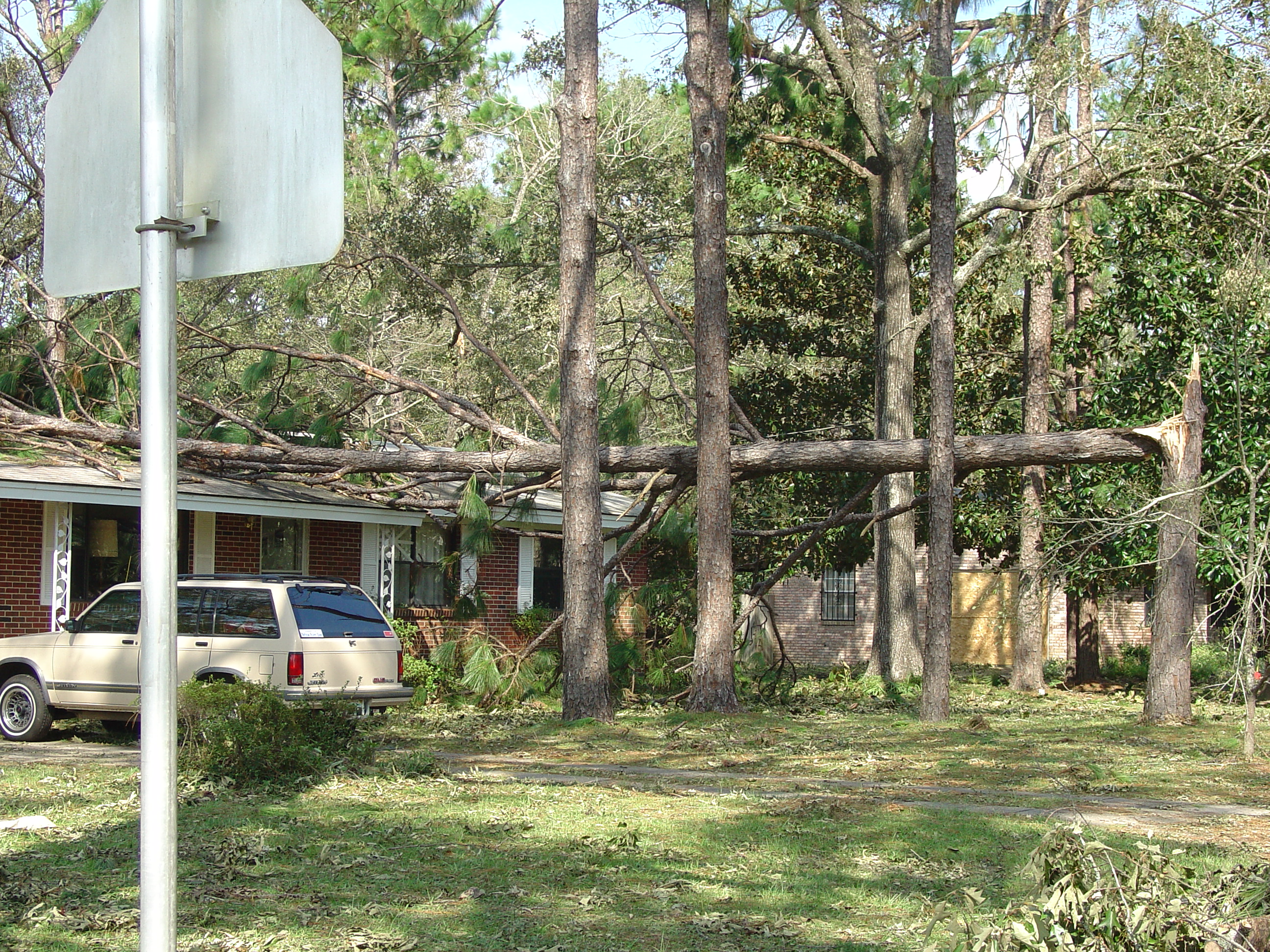
by Larry Williams | Sep 3, 2015
Tropical storm season officially ends November 30. I’m not predicting a storm but even with our average winds during a typical thunderstorm, you’d be wise to prepare.
Falling trees and flying landscape debris during a storm can cause damage. Evaluate your landscape for potential tree hazards. Pruning or removing trees once a hurricane watch has been announced is risky and tree trimming debris left along the street is hazardous.
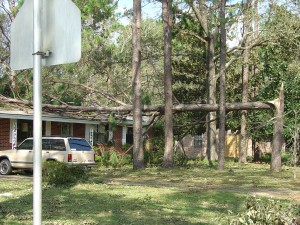
Photo credit: Larry Williams, UF/IFAS.
Now is a good time to remove dead or dying trees and to prune decayed or dead branches Also inspect trees for signs of disease or insect infestation that may further weaken them.
Professional help sometimes is your best option when dealing with larger jobs. Property damage could be reduced by having a professional arborist evaluate unhealthy, injured or questionable trees to assess risk and treat problems. Hiring a certified arborist can be a worthwhile investment. To find a certified arborist in your area contact the International Society of Arboriculture (ISA) at 217-355-9411 or at www.isa-arbor.com. You also may contact the Florida Chapter of ISA at 941-342-0153 or at www.floridaisa.org.
Consider removing trees that have low wind resistance, are at the end of their life span or that have potential to endanger lives or property. For example, laurel oaks are relatively short-lived, usually showing considerable dieback as they reach 50 years. They tend to lose their strength and stability faster than most other oaks and have low wind resistance. Consider removing a big, old laurel oak within falling distance of your home before the next storm.
Tree species with the lowest wind resistance include pecan, tulip poplar, cherry laurel, Bradford pear, southern red oak, laurel oak, water oak, Chinese tallow, Chinese elm, southern red cedar, Leyland cypress, sand pine and spruce pine.
Pine species vary in their wind resistance, usually with longleaf and slash pines showing better survival rates than loblolly and sand pine. However, when pines become large, they may cause damage if located close to homes or other valuable structures.
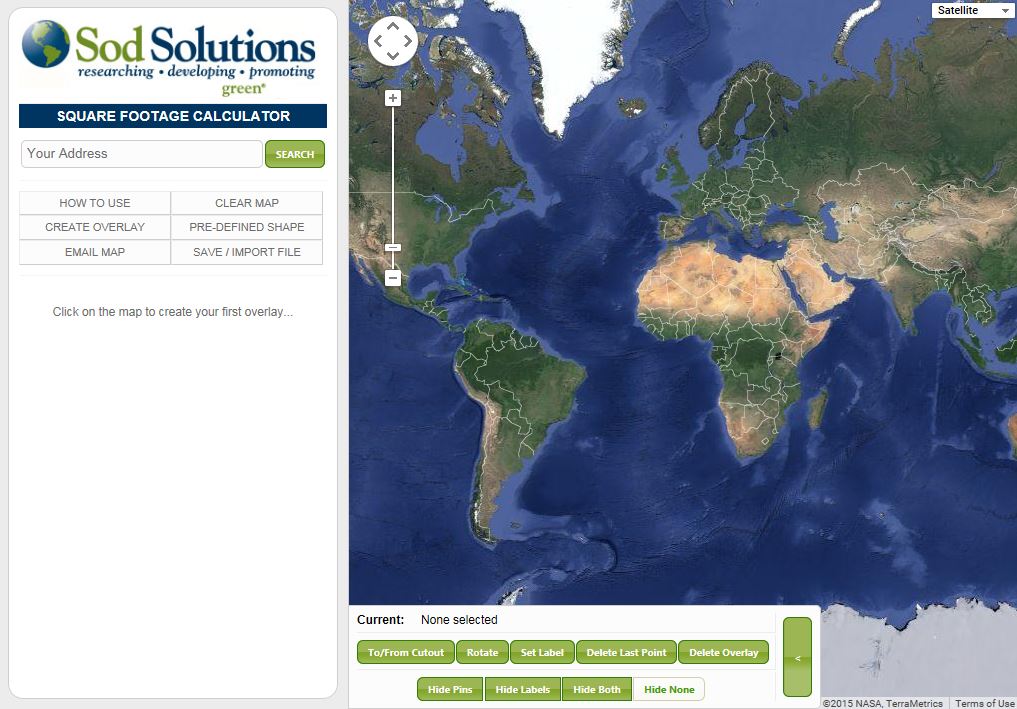
by Mary Salinas | Aug 19, 2015
When you know that your lawn needs an application of fertilizer, herbicide, insecticide or fungicide, the question becomes how much to buy and put down. For these products, success stems from applying the right amount, not too much or too little. The label on those products always tells the consumer how many square feet of lawn can be treated, but how do you figure that out?
You could always do it the old-fashioned way with measuring tape and a calculator, estimating the angles and the areas of those curvy, irregular flower beds. This method takes a bit of time and you will still wonder about the accuracy of your final numbers.
Here’s an easier, and more accurate way to do it!
Sod Solutions, Inc. offers an online tool that is easy to use and very accurate. Enter your address and GPS locates the aerial view of your property. Create an overlay by plotting points and the square footage is automatically calculated. The instructions under ‘How to Use the Calculator’ are very clear and makes this tool so easy and convenient to use.
For more information on lawn care topics:
Gardening Solutions: Lawns
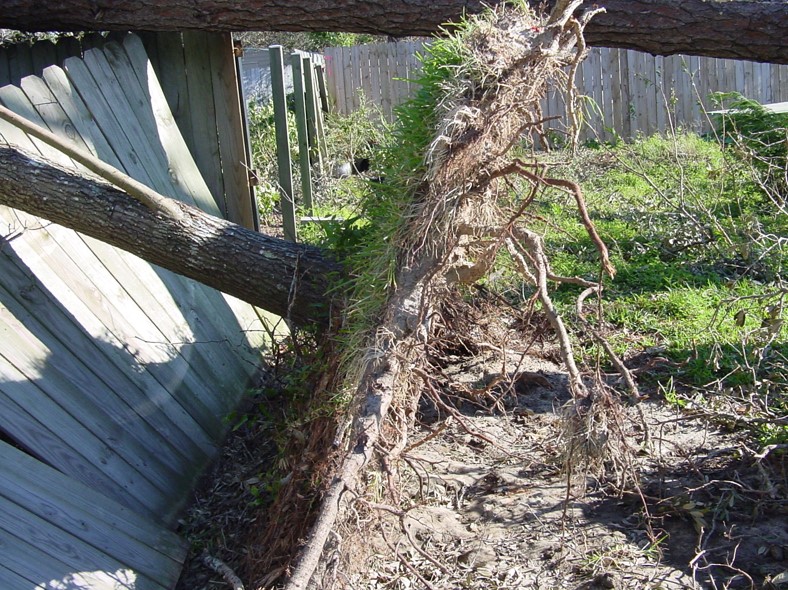
by Carrie Stevenson | Feb 10, 2015
After storms and when homeowners are doing “spring cleaning” around their yards, Extension agents are routinely asked about whose responsibility it is to maintain a tree along a property line. This becomes particularly important in a situation where a property owner’s tree or branch falls and causes damage to their neighbor’s home or possessions.
To clarify this often contentious issue, reference to legal experts is necessary. In a series of publications called “The Handbook of Florida Fence and Property Law,” two attorneys and a University of Florida law student explain several statutes that give us direction. The section on “Trees and Landowner Responsibility” goes into further detail and cites case-law, but for ease of reading it is summarized below.
Situation 1: Removing a healthy tree on a shared property line.
If two neighbors share a tree on their property line and one of them wants to remove it, the adjoining landowner must give their permission. Removing trees can impact property value, heating/cooling bills, or aesthetic value. Without a neighbor’s consent, the landowner cutting down a tree can be legally liable for damages.
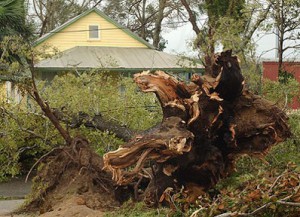
Hurricanes can have serious impacts on trees in their path. Photo credit: Pensacola News Journal
Situation 2: Responsibility for overhanging branches and roots.
Let’s imagine a big spring storm hits your neighborhood, with tons of rain, wind, and lightning. You wake up in the morning and see that a large branch fell from your neighbor’s tree and crushed your kids’ basketball goal. If branches from the neighbor’s tree were otherwise healthy, they are not responsible for any damages resulting from the tree. If it was dead, however, and their negligence contributed to the branch falling, they will be responsible for damages.
Keep in mind that if the neighbor’s tree/branches/roots are in good health but interfering with something in your yard, you may trim them at your own expense. The same goes for your tree hanging in their yard, so while it’s not required, it’s always good to have a conversation first to let them know your plans.
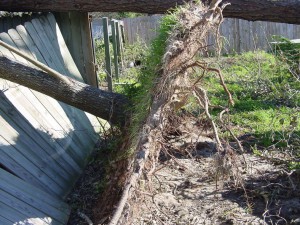
After Hurricane Ivan, this tree’s root system completed uprooted and destroyed and adjacent fence. Photo credit: Beth Bolles
Situation 3: Hurricane Ana, the first big storm of 2015, blows your neighbor’s tree over, into your yard.
Just like the situation with branches and roots, the same principle goes for an entire tree falling on adjoining property—if the tree was alive, it’s the responsibility of the person whose yard it fell in. If it was dead when it fell, it’s the responsibility of the tree’s owner to pay for damages.
In a complicated situation involving property damage, the saying, “good fences make good neighbors” only goes so far. Be sure to note the health of your trees throughout the year and trim back dead or dying branches. If you see serious decay or have concerns about a tree’s health, contact your county Extension office or a certified arborist. Finally, if the circumstances aren’t easily determined, be sure to contact a licensed attorney and/or your insurance company for direction.

by Julie McConnell | Oct 8, 2014
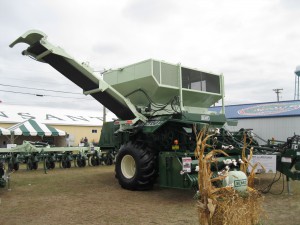 By Brad Buck, 352-294-3303, bradbuck@ufl.edu
By Brad Buck, 352-294-3303, bradbuck@ufl.edu
GAINESVILLE, Fla. – You can find out when to plant crops, how to can foods safely and how to use paper to pot plants from University of Florida experts at the 37th annual Sunbelt Ag Expo.
The Sunbelt Ag Expo, Oct .14-16 in Moultrie, Ga., is the largest agricultural expo in the southeast, and more than 100,000 people attend each year.
“The Sunbelt Expo gives people from all walks of life a chance to learn about everything Extension offers from our experts,” said Nick Place, dean of Extension for UF’s Institute of Food and Agricultural Sciences.
Known as North America’s Premier Farm Show and the largest such show in the U.S., the expo unites all segments of rural living. The setting features the latest agricultural research, a live farm harvest and insights into various agricultural businesses, according to its website.
UF/IFAS will have a permanent building, popular with visitors because of engaging displays and giveaways such as peanuts from the Florida Peanut Growers Association, Florida Orange Juice provided by Natalie’s Orchid Island Juice Company and many other “Gator Giveaways.”
This year, the Extension Service celebrates the centennial of the Smith-Lever Act of 1914, which created the national service, in which agents deliver unbiased research data to their constituents. Florida’s program remains as viable as ever, helping its many stakeholders. That includes guiding growers to maximize production through the most efficient use of their resources.
UF/IFAS’s three branches, Extension, research and the College of Agricultural and Life Sciences (CALS) will feature six interactive booths with the theme “Solutions for the Next 100 Years.”
Experts will interact with the public on several topics:
- “Canning parties” were some of the first Extension programs to help people better understand how to safely preserve foods. Expo visitors can learn more about this tradition as Family and Consumer Science Extension agents share from the past and present to provide the latest innovations for home food preservation.
- 4-H is one of UF/IFAS’ oldest recognized Extension programs. See how youth are leading and learning to meet the challenges of the next century. Visitors will learn about a 4-H recycling project and can take home a start to their family garden.
- Farming tools and methods are constantly improving. Visitors can see some of UF/IFAS’ favorites from the past and contrast them with flyin
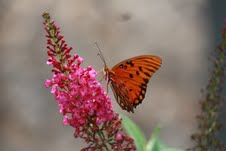 g drones and infrared scanners for today and the future. These new tools aid farmers in early identification of disease, pest and nutritional problems.
g drones and infrared scanners for today and the future. These new tools aid farmers in early identification of disease, pest and nutritional problems.
- Natural Resource and Sea Grant Extension agents are bringing Florida’s beaches and bays to Georgia. Touch tanks and displays with animals will highlight this exhibit focused on beach and boating safety and stewardship.
- Horticulture displays will give visitors insight into establishing a Florida Friendly yard by using appropriate plants and cultural methods. Butterfly gardening plants will be featured. Visitors will also learn how to distinguish beneficial insects from problem pests.
- Visit with CALS Ambassadors and learn about life as a UF agriculture student. Ambassadors will give information about major programs, admission, enrollment and hand out plenty of Gator goodies.
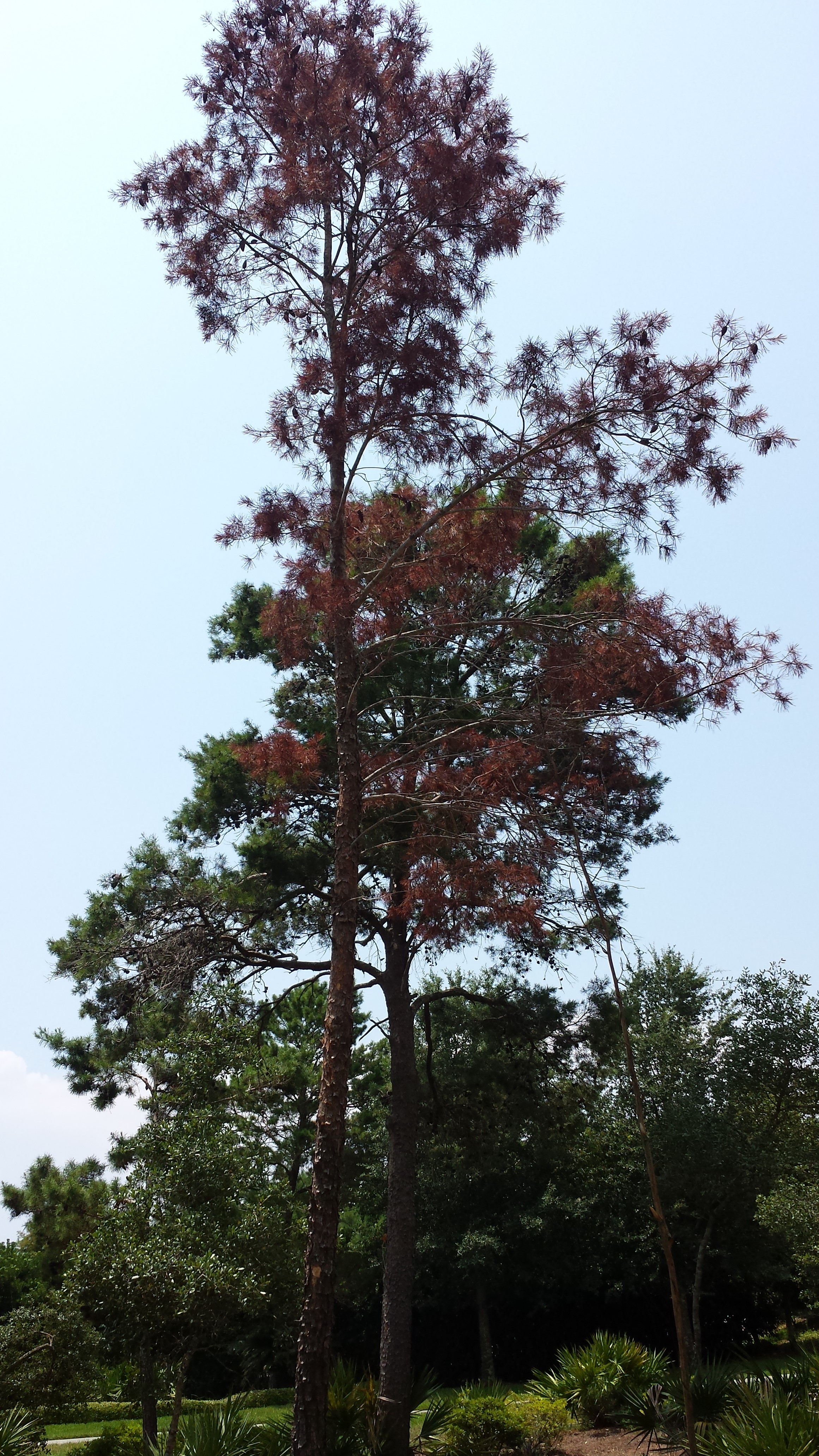
by Sheila Dunning | Aug 19, 2014
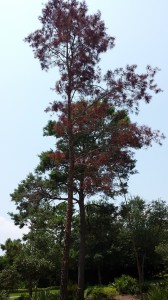 Pine bark beetles are frequent pests of stressed pines in the southern United States. The five most common southern pine bark beetle species include three in the genus Ips. Ips beetles usually colonize only those trees that are already stressed, declining, or fallen due to environmental factors. Infestations may occur in response to drought, root injury, disease, lightning strikes or other stresses including flooding.
Pine bark beetles are frequent pests of stressed pines in the southern United States. The five most common southern pine bark beetle species include three in the genus Ips. Ips beetles usually colonize only those trees that are already stressed, declining, or fallen due to environmental factors. Infestations may occur in response to drought, root injury, disease, lightning strikes or other stresses including flooding.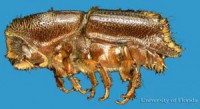
Ips calligraphus usually attacks the lower portions of stumps, trunks and large limbs greater than 4” in diameter. Early signs of attack include the accumulation of reddish-brown boring dust on the bark, nearby cobwebs or understory foliage. Ips calligraphus can complete their life cycles within 25 days during the summer and can produce eight generations per year in Florida. Newly-emerged adults can fly as far as four miles in their first dispersal to find a new host tree, whichever one is the most stressed.
Most trees are not well adapted to saturated soil conditions. With record rainfall this past April, the ground became inundated with water. When the root environment is dramatically changed by excess moisture, especially during the growing season, a tree’s entire physiology is altered, which may result in the death of the tree.
Water saturated soil reduces the supply of oxygen to tree roots, raises the pH of the soil, and changes the rate of decomposition of organic material; all of which weakens the tree, making it more susceptible to indirect damage from insects and diseases.When the ground becomes completely saturated, a tree’s metabolic processes begin to change very quickly. Photosynthesis is shut down within five hours; the tree is in starvation mode, living on stored starches and unable to make more food. Water moves into and occupies all available pore spaces that once held oxygen. Any remaining oxygen is utilized within three hours. The lack of oxygen prevents the normal decomposition of organic matter which leads to the production and accumulation of toxic gases such as carbon dioxide, methane, hydrogen sulfide and nitrogen oxide. Additionally, within seven days there is a noticeable root growth loss. Roots only develop when soil oxygen levels are at 5% -15%. Over time, the decaying roots are attacked by pathogens. The loss of root mass from decay and fungal attack leaves the tree prone to drought damage. After only two weeks of saturated soil conditions the root crown area can have so many problems that decline and even death are imminent.
When a tree experiences these anaerobic soil conditions it will exhibit symptoms of leaf loss with minimal to no new leaf formation. This usually appears two to eight weeks after the soil dries out again. Many trees will not survive, especially the more juvenile and mature trees. However, well established trees may still decline several years later, if they experience additional stresses such as drought or root disturbance from construction.
There is little that can be done to combat the damage caused by soil saturation. However, it is important to enable the tree to conserve its food supply by resisting pruning and to avoid fertilizing until the following growth season. Removal of mulch will aid in the availability of soil oxygen. Basically, it is a “wait and see” process. While water is essential to the survival of trees, it can also be a detriment when it is excessive, especially for drought tolerant pine species such as Sand Pine, which is prevalent throughout the coastal areas.
For urban and residential landscape trees, preventative strategies to avoid tree stress and therefore reduce the chances of infestation include the following:
1) avoiding compaction of, physical damage to, or pavement over the root zones of pines,
2) providing adequate spacing (15-20ft) between trees,
3) minimizing competing vegetation beneath pines,
4) maintaining proper soil nutrient and pH status and
5) limiting irrigation to established pine areas.
When infested trees are removed, care should be taken to avoid injury to surrounding pines, which could attract the more harmful pine bark beetle species Dendroctonus frontalis, the Southern Pine Bark beetle.
There is no effective way to save an individual tree once it has been successfully colonized by Ips beetles. In some cases, the application of an approved insecticide that coats the entire tree trunk may be warranted to protect high-value landscape trees prior to infestation. UF/IFAS Extension can assist with recommendations.
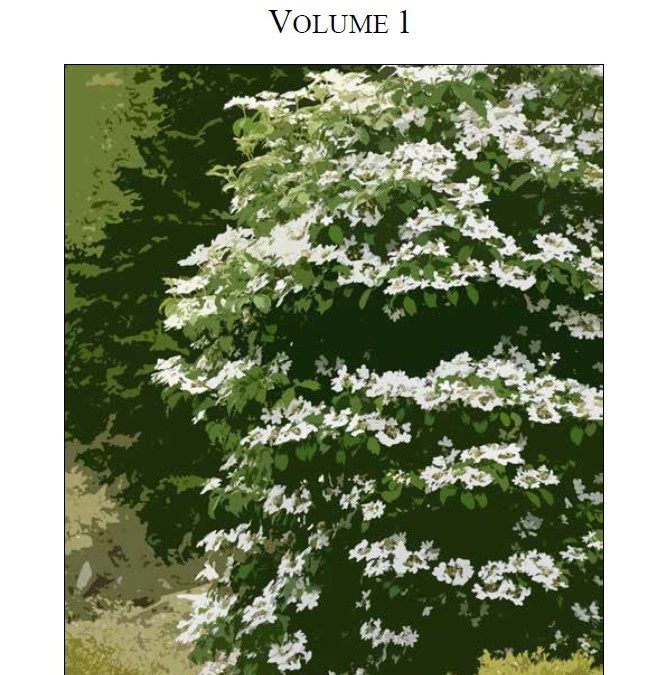
by Gary Knox | Aug 19, 2014
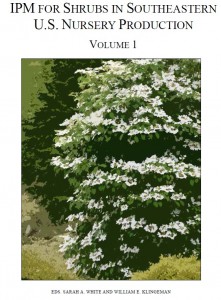 A new IPM guide is making it easier to grow five common southeastern shrubs. Growing five southeastern shrubs is now easier thanks to a free, new IPM resource from the Southern Nursery IPM Working Group.
A new IPM guide is making it easier to grow five common southeastern shrubs. Growing five southeastern shrubs is now easier thanks to a free, new IPM resource from the Southern Nursery IPM Working Group.
IPM for Shrubs in Southeastern U.S. Nursery Production is a compilation of Integrated Pest Management (IPM) information for five major shrubs in nursery crop production in the southeast. This 175 page book covers sustainable management for insects, mites, diseases, and weeds for these shrubs, as well as nursery production information. This IPM resource was developed for nursery growers although professional landscape managers and collectors of these plants also will find the information valuable.
Individual chapters cover abelia (Abelia spp.), camellia (Camellia spp.), shrub rose (Rosa spp.), blueberry (Vaccinium spp.) and viburnum (Viburnum spp.). Each chapter provides comprehensive information on the species, primary cultivars and their nursery production. Major pests, diseases, weeds and abiotic disorders are presented for each genus along with sustainable management methods and tables listing labeled pesticides and fungicides by mode of action and site. An additional chapter discusses weed management in shrub production. Future volumes covering additional shrubs are anticipated.
Edited by Clemson University’s Sarah A. White and University of Tennessee’s William E. Klingeman, this free guide was developed by the Southern Nursery IPM Working Group, including University of Florida NFREC’s Gary Knox and Mathews Paret. The award-winning, multi-disciplinary group is composed of experts from universities across the southeast. This group formed in 2008 to develop and deliver educational programming to the southern U.S. nursery industry and Extension personnel. The team recently won the 2014 Bright Idea Award from the Friends of Southern IPM and Southern IPM Center.
This resource joins the tree IPM book previously released by this group, IPM for Select Deciduous Trees in Southeastern US Nursery Production. The tree IPM book is similar to the new resource in that it contains IPM information for insects, mites, diseases, and weeds of nine major tree crops as well as production information. Individual chapters cover birch (Betula spp.), cherry (Prunus spp.), crapemyrtle (Lagerstroemia spp.), dogwood (Cornus spp.), chinese elm (Ulmus parvifolia), magnolia (Magnolia spp.), maple (Acer spp.), oak (Quercus spp.) and redbud (Cercis spp.).
Both books can be downloaded free through iTunes (http://www.apple.com/itunes/) or each chapter is available as a free pdf through the Southern Nursery IPM Working Group website, http://wiki.bugwood.org/SNIPM. A limited number of hardcopy books were printed and distributed to authors. Thanks to the Southern Region IPM Center for their generous support to make this resource possible!










 g drones and infrared scanners for today and the future. These new tools aid farmers in early identification of disease, pest and nutritional problems.
g drones and infrared scanners for today and the future. These new tools aid farmers in early identification of disease, pest and nutritional problems.




